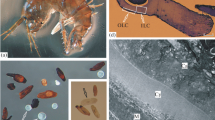Summary
Studies of the cysticercoids of Hymenolepis nana from insects and from mouse villi revealed important differences in cyst structure and function. The insect form resists low pH unless treated with bile salts which render the cyst permeable and reduce infectivity to mice. Bile salts are not essential for scolex activation. Activation is inhibited by pH 2.5 and under and by 1% succinic acid up to pH 4.0. The importance of scolex immobility and energy conservation in relation to cyst impermeability is discussed. The villus cysticercoid has no special insulating layer. It is vulnerable to low pH and cannot infect mice orally. Bile salts are without effect and excystment occurs unaided by external agents. The structural differences between the two forms revealed by the electron microscope may be attributed to changes in the relative rates of development of the various tissues.
Similar content being viewed by others
References
Allison, V. F., Uberlaker, J. E., Cooper, N. B.: The fine structure of the cysticercoid of Hymenolepis diminuta. II. The inner wall of the capsule. Z. Parasitenk. 39, 137–147 (1972)
Berntzen, A. K.: Continuous axenic culture of the successive stages of the life cycle of Hymenolepis nana. J. Parasit. 56, II Part 2, 397 (1970)
Caley, J.: The functional significance of scolex retraction and subsequent cyst formation in the cysticercoid larva of Hymenolepis microstoma. Parasitology 68, 207–227 (1974)
Campbell, W. C.: The efficacy of surface-active agents in stimulating the evagination of cysticerci in vitro. J. Parasit. 49, 81–84 (1963)
Glassman, H. N.: Surface active agents and their application in bacteriology. Bact. Rev. 12, 105–148 (1948)
Goodchild, C. G., Davis, B. O.: H. microstoma cysticercoid activation and excystation in vitro (Cestoda). J. Parasit. 58, 735–741 (1972)
Henry, H., Stacey, M.: Histochemistry of the gram-staining reaction of micro-organisms. Nature (Lond.) 151, 671 (1943)
Heyneman, D.: Studies on helminth immunity. III. Experimental verification of autoinfection from cysticercoids of Hymenolepis nana in the white mouse. J. infect. Dis. 109, 10–18 (1961)
Hunninen, A. V.: Studies on the life history and host-parasite relations of Hymenolepis fraterna (H. nana var. fraterna) in white mice. Amer. J. Hyg. 22, 414–443 (1935)
Jacobsen, N. S., Fairbairn, D.: Lipid metabolism in helminth parasites. III. Biosynthesis and interconversion of fatty acids by H. diminuta (Cestoda). J. Parasit. 53, 355–361 (1967)
Rothman, A. H.: Studies on the excystment of tapeworms. Exp. Parasit. 8, 336–364 (1959)
Rycke, P. H. de, Grembergen, G. van: Study on the evagination of Cysticercus pisiformis. Z. Parasitenk. 27, 341–349 (1966)
Smith, C F: Attempts at in vitro cultivation of the fowl cestode Raillietina cesticillus. J. Parasit. 40, Suppl. 41–42 (1955)
Smyth, J. D.: The Physiology of Cestodes. Edinburgh: Oliver and Boyd 1969
Smyth, J. D., Haslewood, G. A. D.: The biochemistry of bile as a factor in determining host specificity in intestinal parasites, with particular reference to Echinococcus granulosus. Ann. N. Y. Acad. Sci. 113, 234–260 (1963)
Voge, M., Heyneman, D.: Development of Hymenolepis nana and H. diminuta in the intermediate host Tribolium confusum. Univ. Calif. Publ. Zool. 59, 549–580 (1957)
Voge, M., Heyneman, D.: Effect of high temperature on the larval development of Hymenolepis nana and Hymenolepis diminuta. J. Parasit. 44, 249–260 (1958)
Waele, A. de: Investigation on the biochemical mechanism of the influence of bile salts, acetylcholine and choline on the evagination of cysticerci of the cestodes. Med. roy. vlaam. Acad., Kl. Wetensch. 1, 3–19 (1940)
Waele, A. de, Dedeken, L.: Le phénoménon de l'évagination chez Cysticercus bovis et la migration du parasite chez l'homme. Mém. Mus. roy. Hist. nat. belg. 2, 369–373 (1936)
Author information
Authors and Affiliations
Rights and permissions
About this article
Cite this article
Caley, J. A comparative study of the two alternative larval forms of Hymenolepis nana, the dwarf tapeworm, with special reference to the process of excystment. Z. F. Parasitenkunde 47, 217–235 (1975). https://doi.org/10.1007/BF00418205
Received:
Issue Date:
DOI: https://doi.org/10.1007/BF00418205




